Preliminary setup
We recommend using a local Creatio instance to connect the libraries of Creatio classes, deploy the local database from an archive copy, and use the WorkspaceConsole utility. The examples in this article assume Creatio is installed into the C:\Creatio local directory.
The examples for Creatio in the cloud use the Executor utility in the C:\Executor directory. You can download the utility set up to execute the example via the following link: Download the utility.
Write C# code for Creatio on-site
1. Restore the database from backup (if needed)
Deploy the Creatio database from backup. The archived Creatio database backup is in the C:\Creatio\db directory.
2. Set up the WorkspaceConsole utility
To manage the deployed database, set up the WorkspaceConsole utility using Creatio files:
- Open the C:\Creatio\Terrasoft.WebApp\DesktopBin\WorkspaceConsole directory.
- Execute the PrepareWorkspaceConsole.x64.bat or PrepareWorkspaceConsole.x86.bat batch file depending on the Windows version.
- Specify the database connection parameters in the Terrasoft.Tools.WorkspaceConsole.exe.config file in the C:\Creatio\Terrasoft.WebApp\DesktopBin\WorkspaceConsole directory. For example, if the CreatioDB database is deployed on the dbserver server, the connection string looks as follows:
3. Create and set up a Visual Studio project
Create a standard class library project in Visual Studio.
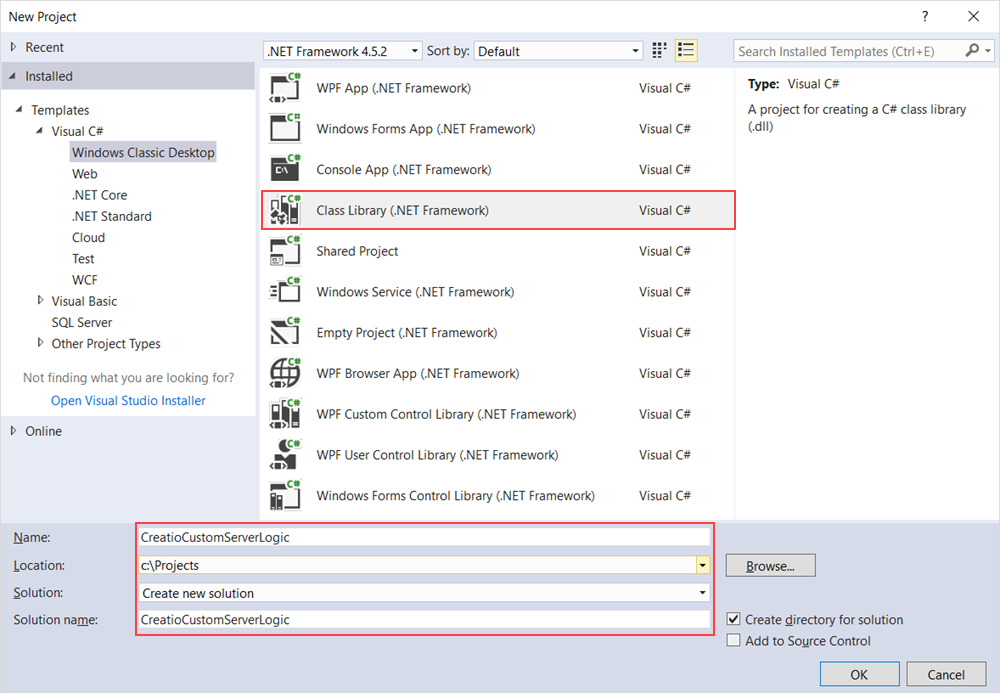
Use the Debug tab of the class library project's properties window to specify the full path to the configured WorkspaceConsole utility in the Start external program property. The WorkspaceConsole utility is used as an external debugger of the developed software logic.
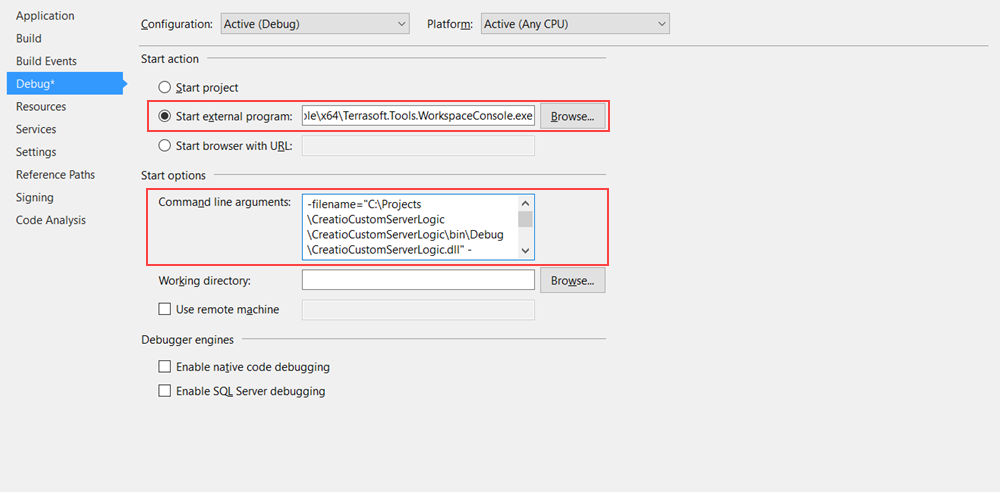
Set the following WorkspaceConsole launch arguments in the Command line arguments property:
- Specify the full path to the debug version of the developed class library in the -filename argument, for example, "C:\Projects\CreatioCustomServerLogic\CreatioCustomServerLogic\bin\Debug\CreatioCustomServerLogic.dll."
- Specify the full name of the class to implement the developed software logic, including the names of every namespace, in the -typeName argument, for example, "CreatioCustomServerLogic.MyContactCreator."
- Specify the WorkspaceConsole operation in the -operation argument, for example, "ExecuteScript."
- Specify the workspace name in the -workspaceName argument, for example, "Default."
- Specify the path to the parent directory of the conf directory in the -confRuntimeParentDirectory argument, for example, "C:\creatio\Terrasoft.WebApp."
To use the Creatio core’s server-side classes, set up dependencies from the appropriate Creatio class libraries in the created project. For example, add a dependency from the Terrasoft.Core.dll library.
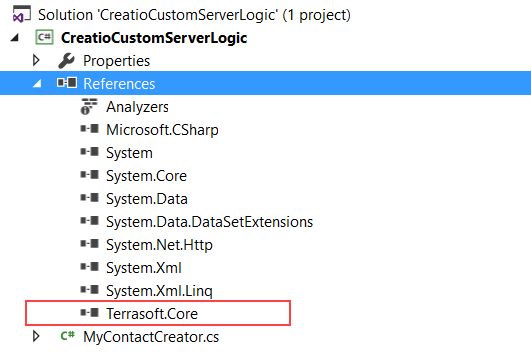
You can find class libraries of the Terrasoft namespace in the Terrasoft.WebApp\DesktopBin\WorkspaceConsole directory of the Creatio distribution.
4. Develop the functionality
Add a class to the created class library project. The full class name must match the name specified in the -typeName argument of the WorkspaceConsole utility’s launch argument string. For example, "CreatioCustomServerLogic.MyContactCreator." The class must implement the Terrasoft.Core.IExecutor interface.
After you run the project (F5 key), the WorkspaceConsole window that contains the corresponding message appears.

You can also set a breakpoint on any line of code and see what the values of variables are while the program is running (i. e., debug the program).
View the execution outcome of the aforementioned code in the Contacts Creatio section or by executing the database request.
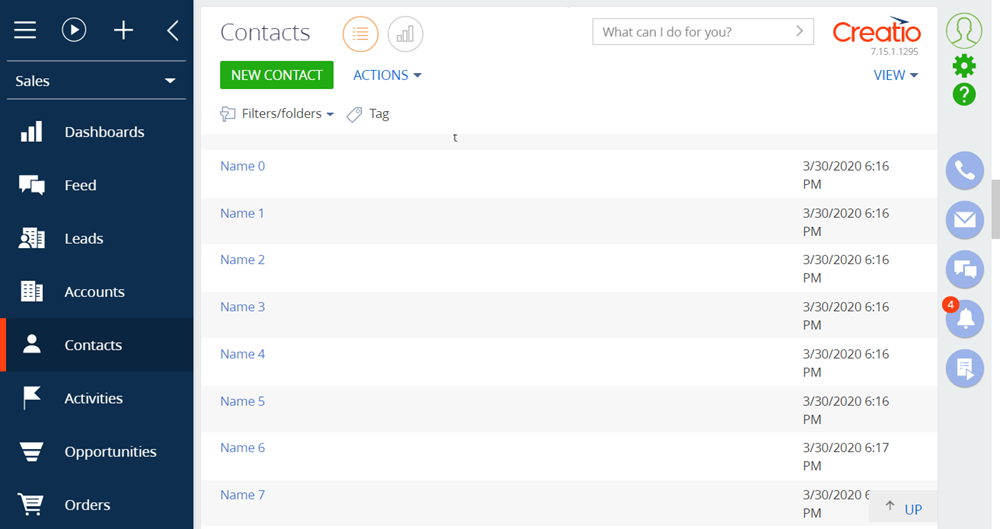

Write C# code for Creatio in the cloud
1. Create a class library project
Create a standard class library project in Visual Studio. For example, name the project "CreatioCustomServerLogic.Cloud."
To use the Creatio core’s server-side classes, set up the dependencies from the necessary Creatio class libraries in the created project. For example, add a dependency from the Terrasoft.Core.dll library.
Specify the full path to the configured Executor utility ("C:\Executor\Executor.exe") and select the condition to launch the library build event (Always) in the Post-build event command line property on the BuildEvents tab of the created class library project’s properties window.
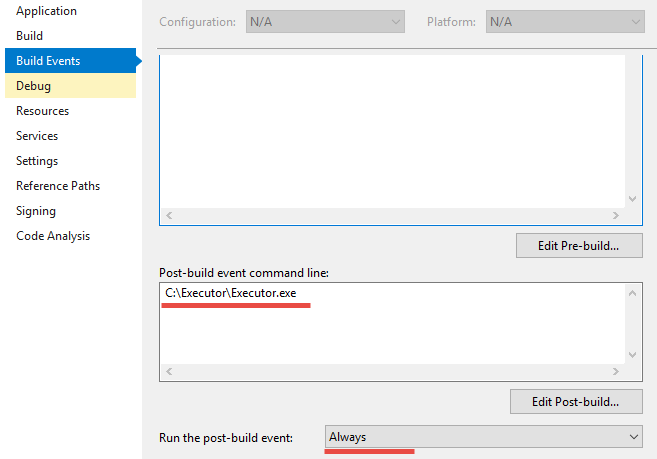
2. Develop the functionality
Add the class that implements the Terrasoft.Core.IExecutor interface to the created class library project.
3. Set up the Executor utility
Open the directory that contains the installed Executor utility (C:\Executor). Then, set the values of the following setup elements in the configuration file:
- Specify the URL of the Creatio application loader in the Loader element. Usually, this is the Creatio website URL, for example, "https://mycloudapp.creatio.com."
- Specify the Creatio application URL in the WebApp element. Usually, this is the path to the default Creatio configuration, for example, "https://mycloudapp.creatio.com/0."
- Specify the name of the Creatio user in the Login element, for example, "Supervisor."
- Specify the password of the Creatio user in the Password element.
- Specify the path to the original class library copy in the LibraryOriginalPath element. Usually, this is a path to where the Visual Studio creates a class library after the compilation, for example, "C:\Projects\CreatioCustomServerLogic\CreatioCustomServerLogic.Cloud\bin\Debug\
CreatioCustomServerLogic.Cloud.dll ." - Specify the path to create a class library copy that interacts with the remote server in the LibraryCopyPath element. You can specify any temporary directory or a directory that contains the Executor utility, for example, "C:\Executor\CreatioCustomServerLogic.Cloud.dll."
- Specify the full name of the class to implement the developed software logic, including the names of all namespaces, in the LibraryType element, for example, "CreatioCustomServerLogic.Cloud.MyContactReader."
- Enter the name of the class library in the LibraryName element, for example, "CreatioCustomServerLogic.Cloud.dll."
4. Execute the developed code
To launch the building process, use the Build Solution and Rebuild Solution menu commands.
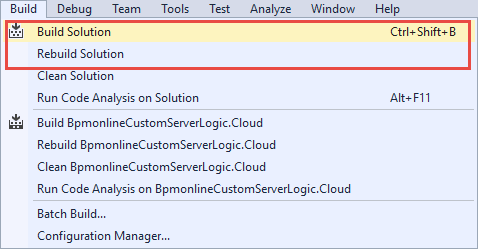
View the execution outcome of the developed code in the Output window of Visual Studio after each successful build of the class library.

